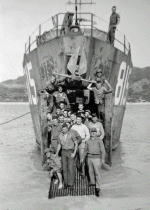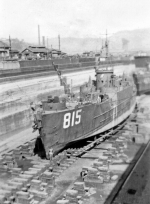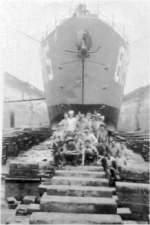Click On Image
For Full Size Image |
Size |
Image Description |
Source |
 |
92k |
USS LCI(L)-815 beached at Sesoke Shima. "Arrangements were being made for us to make a beaching at Sesoke Shima. This small island, only about 3 or 4 miles in diameter was just south of Ie Shima and only about a mile off the west coast of Okinawa. We had about 30 men and officers to put ashore. We expected no trouble as we were advised the Japanese troops had left for the north end of Okinawa." from the journal of George A. Quandee. |
Kristine Quandee for her father LT George A. Quandee CO USS LCI(L)-815 |
 |
117k |
 |
399k |
 |
47k |
USS LCI(L)-815 crew photos while the ship was at Okinawa, circa August 1945.
These photographs was purchased at an estate sale in Chagrin Falls, Ohio. |
Tommy Trampp |
 |
95k |
USS LCI(L)-815 underway with Japanese Prisoners-of-War, circa August 1945. "Our work at Okinawa was almost at an end. We spent two or three weeks transporting prisoners from the surrounding islands to a huge complex or compound on Okinawa. The prisoners were a rough looking bunch, very poorly clad and ill fed." from the journal of George A. Quandee. |
Kristine Quandee for her father LT George A. Quandee CO USS LCI(L)-815 |
 |
112k |
USS LCI(L)-815 drydocked at the Japanese Naval Base at Sasebo, Japan, circa September-November 1945. "We spent several days clearing the area. Slowly we inched our way into the harbor, sweeping and destroying the mines as they were lifted. Thus we finally completed our share of the chore.
No sooner was the word passed that the channels were clear, ships that had been riding at anchor offshore entered the harbor. They tied up at the various wharfs and docks that encompassed the harbor to unload their cargo and troops with their gear. The ships for the most part were large transports and supply ships. I’m certain these were bringing in the occupation troops. From that time on, each day the harbor traffic grew to what appeared to be its capacity. Liberty boat service was quickly established and provided excellent transportation ashore responding to call by flag hoist signal.
It was only a few days later we were ordered to prepare to move into dry dock. On the harbors west side, as part of the Japanese Naval Base, were situated two huge dry docks of the graving type. They appeared large enough to accommodate a half dozen or more of our size ships. We understood the steel gates which held the water out of the concrete excavations had been damaged by aircraft raids during the war. They were however soon to complete the repairs and again be operational. We were scheduled to be one of the first ones into the huge docks so I presumed we were to be sort of a sea going guinea pig to test the effectiveness of the repairs.
The work to be done to our ships consisted of a thorough inspection, cleaning and painting of the hull, repairs as needed for replacement of our plates and scraping and painting of all topsides. Our crew was to do the top-side work and the Japanese the underwater hull sides and bottom. Theirs was a very messy and dirty job.
About a week later on the appointed day we entered the dock. The steel gates closed and the lengthy task of pumping out the huge basin started. The entire operation was undertaken by the Japanese who gently settled us down on the wooden keel blocks or timbers which formed like “waves” under the ship. Our engines were secured, our generators shut down and for the first time in a year it became unbelievably quiet. The only sound heard was the quiet hum of the gyro compass which after a while was also still. Our power was expeditiously provided from ashore and connections were made to the ship by our electricians and motor-machinists mates.
We were in the dock for a week which provided an opportunity for alternate watches to have liberty ashore. Those who remained aboard were to apply themselves to the needs of the ship. This consisted mostly of scraping and painting of the topsides.
The dedication of the Japanese to the task at hand never ceased to amaze me. The cleaning and painting of a ships bottom is a difficult and dirty task. Working overhead, at scraping and painting for hours on end is physically trying to say the least. In spite of this, each morning I was awakened by jabbering coming from below the ship. With the light of day all would be hard at the work of scraping, painting, repairing etc. Speaking of repairing, the damage done to our bottom at Nagasaki was minimal consisting only of a bad dent.
Inspection of our zinc plates, installed at the ships double rudders, props and shaft supports were all but gone. The plates had accomplished their job and were eaten away by the electrolytic action with the sea water from the steel to the brass parts."
from the journal of George A. Quandee. |
Kristine Quandee for her father LT George A. Quandee CO USS LCI(L)-815 |
 |
323k |
 |
16k |
USS LCI(L)-815 wile in drydock at Sasebo, Japan, circa September-November 1945.
This photograph was purchased at an estate sale in Chagrin Falls, Ohio. |
Tommy Trampp |
 |
77k |
USS LCI(L)-815 underway in San Francisco Bay, CA., following the end of World War II.
US Naval History and Heritage Command photo # NH 89264, courtesy of William H. Davis, 1979. |
US Naval History and Heritage Command |








